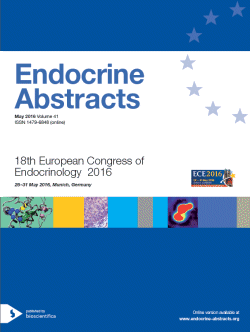Oral Communications
Neuroendocrinology
ea0041oc5.1 | Neuroendocrinology | ECE2016
The Drosophila AIP orthologue is essential for actin cytoskeleton stabilisation and cell adhesion
Aflorei Elena Daniela , Klapholz Benjamin , Moderau Nina , Baptista-Ribeiro Paulo , Tapon Nic , Brown Nick , Stanewsky Ralf , Korbonits Marta
ea0041oc5.2 | Neuroendocrinology | ECE2016
Analysis of signal transduction in mice overexpressing mutant versus intact IGFBP-2 identifies a plethora of IGFBP-2 dependent mechanisms in different tissues and suggests permissive or regulatory effects of the RGD-sequence
Hoeflich Andreas , Reyer Anja , Schindler Nancy , Ohde Daniela , Wirthgen Elisa , Brenmoehl Julia
ea0041oc5.3 | Neuroendocrinology | ECE2016
Development of a long-acting growth hormone antagonist for the treatment of acromegaly
Wilkinson Ian , Pradhananga Sarbendra , Speak Rowena , Sayers Jon , Ross Richard
ea0041oc5.4 | Neuroendocrinology | ECE2016
CNS IL-6 Trans-Signaling is enhanced in obese mice to improve anorexigenic and glucoregulatory effects of IL-6
Timper Katharina , Denson Jesse , Steculorum Sophie Marie , Rose-John Stefan , Wunderlich Frank Thomas , Bruning Jens C
ea0041oc5.5 | Neuroendocrinology | ECE2016
Zebrafish tool for the study of prokineticin receptor 2 (PROKR2) pathway on GNRH3 neuronal development
Bassi Ivan , Marelli Federica , Vezzoli Valeria , Persani Luca , Gothilf Yoav , Bonomi Marco




